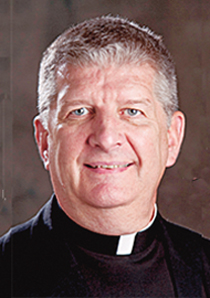
Faith
This Eucharistic Prayer allows for great flexibility, which is evident immediately in its four versions and can inspire parishes and other faith communities to go to the back of the Missal for the treasury of options there.

O'Grady
There are many things that make this Eucharistic Prayer both interesting and, in some ways, unique.
First, it is one Eucharistic Prayer but expressed in four ways. So, your Roman Missal has tabs with VNI, VNII, VNIII, VNIV. Yes, it looks like four Eucharistic Prayers.
This Eucharistic Prayer was, like some of the older ones, written in vernacular languages and translated into Latin before being translated again into vernaculars. It was composed at the request of the bishops of Switzerland for their National Synod following the Second Vatican Council. Since there are three official languages in that nation -- German, French, and Italian -- the prayer was composed in those three languages, and the three were confirmed for use in Switzerland.
Not surprisingly, when those dioceses that used one or the other of those languages asked to use one of those original texts, permission was readily granted. The prayer was dubbed "the Swiss Synod Eucharistic Prayer."
So many requests were coming to the Holy See for permission to use this prayer that an official Latin text, based on the three modern language texts, was issued in 1991. Then, the task of creating translations into the modern languages began its usual process. A first English edition was approved in 1995. The current version in the Roman Missal is the approved version for use in the United States of America.
Initially, the prayer was seen to be used in conjunction with the Mass texts in the Missal's section "Masses for Various Needs and Occasions." And the four variations of the prayer were given titles and "matched up" with certain of the Mass texts. Those titles are: I -- The Church on the Path to Unity, II -- God guides His Church along the Way of Salvation, III -- Jesus the Way to the Father, and IV -- Jesus who went about doing Good.
Another characteristic of this prayer that makes it look like four prayers is that there are variable prefaces for each version, and parallel intercessions for the church. In the Roman Missal, the various versions are arranged so that the preface and its proper intercession for the church are presented as a unit.
The intercession for the church is where we insert the name of the pope and the diocesan bishop (and auxiliary bishops, if there are any). The four intercessions for the church are very different from each other. In VNI, there is the possibility to insert the name of the diocese (but not the parish or another faith community) where the prayer is being used.
The other customary parts of a Eucharistic Prayer, notably the Words of Institution, are the same throughout.
Likewise, the intercessions for the saints and the dead are identical in the four versions.
The intercession for the dead permits the insertion of the name of a deceased individual, but this prayer could not be used at a Funeral Mass as there is a required preface for the dead at that Mass.
Similarly, the prayer could not be used at a Nuptial Mass, at a Mass for Christian Initiation, or of Ordination, nor in the reserved seasons of Advent-Christmas and Lent-Easter.
On the other hand, it might be possible to use one or the other versions on the memorial (but not a solemnity or feast) of a saint. An example is the upcoming memorial here in the U.S. on July 1. That is the memorial of St. Junipero Serra. Since he is noted as a missionary or evangelizer, and VNIII -- Jesus the Way to the Father is appropriate for the Mass for the Evangelization of Peoples, VNIII could be used on his memorial and his name inserted. You would still use his other Mass prayers, but not the preface of Holy Pastors.
And more good news: This Eucharistic Prayer may be used on Sundays in Ordinary Time. Again, think "green vestment" Sundays. The prayer could be used with the texts of the Sunday Mass or with a Mass for a particular need on a Sunday and the suggested respective version of this prayer used.
Such an occasion could be "World Mission Sunday" -- the second last Sunday each October, when the Mass for the Evangelization of Peoples and VNIII could be used in parishes and elsewhere. Another time when this would work nicely would be the "Annual Mission Cooperative Collection" Sunday in a parish.
This Eucharistic Prayer allows for great flexibility, which is evident immediately in its four versions and can inspire parishes and other faith communities to go to the back of the Missal for the treasury of options there.
You can see this prayer in its four versions, nicely laid out and explained here: catholic-resources.org/ChurchDocs/RM3-EPV1-4.htm.
Recent articles in the Faith & Family section
-
Our Lady of DeliveranceJaymie Stuart Wolfe
-
The 'month of the dead' brings its own strange refreshmentBishop Robert Reed
-
Make New Friends, But Keep the OldMaureen Crowley Heil
-
A royal truthScott Hahn
-
St. Cecilia and hope in sacred songRichard Clark


















